Spatio-Temporal Modelling of the Change of Residential-Induced PM10 Pollution through Substitution of Coal with Natural Gas in Domestic Heating
Abstract
:1. Introduction
2. Study Area
3. Data
4. Method
4.1. Setting the Study Area
4.2. Interpolation of PM10 Emissions
4.3. Generating the Difference Map
4.4. Overlay the Surfaces with the Distribution Lines
5. Results and Discussion
6. Conclusions
Author Contributions
Funding
Institutional Review Board Statement
Informed Consent Statement
Data Availability Statement
Conflicts of Interest
References
- Spiekermann, K.; Wegener, M. Modelling urban sustainability. Int. J. Urban Sci. 2011, 7, 47–64. [Google Scholar] [CrossRef]
- Burnett, R.T.; Pope, C.A.; Ezzati, M.; Olives, C.; Lim, S.S.; Mehta, S.; Cohen, A. An Integrated Risk Function for Estimating the Global Burden of Disease Attributable to Ambient Fine Particulate Matter Exposure. Environ. Health Perspect. 2014, 122, 397–403. [Google Scholar] [CrossRef] [PubMed]
- Nam, K.-M.; Li, M.; Wang, Y.; Wong, K.K.H. Spatio-temporal boundary effects on pollution-health costs estimation: The case of PM2.5 pollution in Hong Kong. Int. J. Urban Sci. 2018, 23, 498–518. [Google Scholar] [CrossRef]
- Kumar, A.; Pandey, A.C. Spatio-temporal assessment of urban environmental conditions in Ranchi Township, India using remote sensing and Geographical Information System techniques. Int. J. Urban Sci. 2013, 17, 117–141. [Google Scholar] [CrossRef]
- Boubel, R.W.; Fox, D.L.; Turner, D.B.; Stern, A.C. Fundamentals of Air Pollution, 3rd ed.; Academic Press: London, UK, 1994. [Google Scholar]
- EIA. Natural Gas Explained. From U.S. Energy Information Administration. 24 September 2020. Available online: https://www.eia.gov/energyexplained/natural-gas/natural-gas-and-the-environment.php (accessed on 21 January 2021).
- Fulton, M.; Mellquist, N.; Kitasei, S.; Bluestein, J.; Comparing Life-Cycle Greenhouse Gas Emissions from Natural Gas and Coal. Worldwatch Institute. 25 August 2011. Available online: https://www.westerngrid.net/wp-content/uploads/2012/08/Natural_Gas_LCA_Update_082511.pdf (accessed on 29 January 2021).
- Environmental Impacts of Natural Gas. From Union of Concerned Scientists. 19 June 2014. Available online: https://www.ucsusa.org/resources/environmental-impacts-natural-gas#:~:text=Air%20pollution-,Air%20pollution,diesel%20used%20for%20motor%20vehicles (accessed on 21 January 2021).
- Zhao, C.; Pan, J.; Zhang, L. Spatio-temporal patterns of global population exposure risk of PM2.5 from 2000–2016. Sustainability 2021, 13, 7427. [Google Scholar] [CrossRef]
- Bodor, M. A study on indoor particulate matter variation in time based on count and sizes and in relation to meteorological conditions. Sustainability 2021, 13, 8263. [Google Scholar] [CrossRef]
- Kerimray, A.; Rojas-Solorzano, L.; Torkmahalleh, M.A.; Hopke, P.K.; Gassachoir, B.P. Coal use for residential heating: Patterns, health implications and lessons learned. Energy Sustain. Dev. 2017, 40, 19–30. [Google Scholar] [CrossRef]
- Branis, M.; Domasova, M. PM10 and black smoke in a small settlement: Case study. Athmospheric Environ. 2003, 37, 83–92. [Google Scholar] [CrossRef]
- Bristow, M. World Oil. From Coal Being Replaced by Natural Gas to Generate Electricity. 8 September 2019. Available online: https://www.worldoil.com/news/2019/8/9/coal-being-replaced-by-natural-gas-to-generate-electricity (accessed on 8 September 2019).
- Chen, S.; Chi, H. Analysis of the environmental effects of clean heating policy in Northern China. Sustainability 2021, 13, 6695. [Google Scholar] [CrossRef]
- Mao, X.; Guo, X.; Chang, Y.; Peng, Y. Improving air quality in large cities by substituting natural gas forcoal in China: Changing idea and incentive policy implications. Energy Policy 2005, 33, 307–318. [Google Scholar] [CrossRef]
- Wu, S.; Zheng, X.; Khanna, N.; Feng, W. Fighting coal—Effectiveness of coal-replacement programs for residential heating in China: Empirical findings from a household survey. Energy Sustain. Dev. 2020, 55, 170–180. [Google Scholar] [CrossRef]
- Zhao, N.; Zhang, Y.; Li, B.; Hao, J.; Chen, D.; Zhou, Y.; Dong, R. Natural gas and electricity: Two perspective technologies of substituting coal-burning stoves for rural heating and cooking in Hebei Province of China. Energy Sci. Eng. 2018, 7, 131–210. [Google Scholar] [CrossRef]
- Bulut, U.; Muratoglu, G. Renewable energy in Turkey: Great potential, low but increasing utilization, and an empirical analysis on renewable energy-growth nexus. Energy Policy 2018, 123, 240–250. [Google Scholar] [CrossRef]
- Colak, M.; Kaya, İ. Prioritization of renewable energy alternatives by using an integrated fuzzy MCDM model: A real case application from Turkey. Energy Rev. 2017, 80, 840–853. [Google Scholar] [CrossRef]
- Kaygusuz, K.; Guney, M.S.; Kaygusuz, O. Renewable energy for rural development in Turkey. J. Eng. Res. Appl. Sci. 2019, 8, 1109–1118. [Google Scholar]
- Brozyna, J. Energy consumption and greenhouse gas emissions against the background of Polish economic growth. In Energy Transformation towards Sustainability; Tvaronaviciene, M., Slusarcyzk, S., Eds.; Elsevier: Amsterdam, The Netherlands, 2020; Volume 70, pp. 51–70. [Google Scholar] [CrossRef]
- Brozyna, J.; Strielkowski, W.; Fomina, A.; Nikitina, N. Renewable energy and EU 2020 target for energy efficiency in the Czech Republic and Slovakia. Energies 2020, 13, 956. [Google Scholar] [CrossRef] [Green Version]
- Bilan, Y.; Streimikiene, D.; Vasliyeva, T.; Lyulyov, O.; Pimonenko, T.; Pavlyk, A. Linking between renewable energy, CO2 emissions, and economic growth: Challenges for candidates and potential candidates for the EU membership. Sustainability 2019, 11, 1528. [Google Scholar] [CrossRef] [Green Version]
- Cichowicz, R.; Dobrzanski, M. Modeling pollutant emissions: Influence of two heat and power plants on urban air quality. Energies 2021, 14, 5218. [Google Scholar] [CrossRef]
- Stirelkowski, W.; Volkova, E.; Pushkareva, L.; Streimikiene, D. Innovative policies for energy efficiency and the use of renewables in households. Energies 2019, 12, 1392. [Google Scholar] [CrossRef] [Green Version]
- Genc, D.D.; Yesilyurt, C.; Tuncel, G. Air pollution forecasting in Ankara, Turkey using air pollution index and its relation to assimilative capacity of the atmosphere. Environ. Monit. Assess. 2010, 166, 11–27. [Google Scholar] [CrossRef]
- Gazbir. Natural Gas Distribution Sector Annual Report (Turkish). 2019. Available online: https://www.gazbir.org.tr/2019-dogalgaz-sektor-raporu/files/downloads/2019_YILI_DOGAL_GAZ_DAGITIM_SEKTOOR_RAPORU.pdf (accessed on 22 March 2020).
- Turalıoğlu, F.S. An assessment on variation of sulphur dioxide and particulate matter in Erzurum (Turkey). Environ. Monit. Assess. 2005, 104, 119–130. [Google Scholar] [CrossRef] [PubMed]
- Akay, M.E.; Yıldız, O. Assessing winter-type PM10 pollution in the city of Kırıkkale, Turkey: A case study. Fresnius Environ. Bull. 2007, 16, 57–62. [Google Scholar]
- Tayanç, Y.; Berçin, F. SO2 modeling in İzmit Gulf, Turkey during the winter 1997:3 cases. Environ. Monit. Assess. 2007, 12, 119–129. [Google Scholar] [CrossRef]
- Özden, Ö.; Döğeroğlu, T.; Kara, S. Assessment of ambient air quality in Eskişehir, Turkey. Environ. Int. 2008, 34, 678–687. [Google Scholar] [CrossRef]
- Buzelli, M.; Jerrett, M.; Burnett, R.; Finklestein, N. Spatiotemporal Perspectives on Air Pollution and Environmental Justice in Hamilton, Canada, 1985–1996. Ann. Assoc. Am. Geogr. 2003, 93, 557–573. [Google Scholar] [CrossRef]
- Bayraktar, H.; Turalioğlu, F.S. A Kriging-based approach for locating a sampling site—In the assessment of air quality. Stoch. Environ. Res. Risk Assess. 2005, 19, 301–305. [Google Scholar] [CrossRef]
- Shad, R.; Mesgari, M.S.; Akbar, A.; Shad, A. Predicting air pollution using fuzzy genetic linear membership kriging in GIS. Comput. Environ. Urban Syst. 2009, 33, 472–481. [Google Scholar] [CrossRef]
- Son, J.Y.; Bell, M.L.; Lee, J.T. Individual exposuure to air polluiton and lung function in Korea: Spatial analysis using multiple exposure approaches. Environ. Res. 2010, 110, 739–749. [Google Scholar] [CrossRef]
- Vicedo-Cabrera, A.M.; Biggeri, A.; Grisotto, L.; Barbone, F.; Catelan, D. A Bayesian kriging model for estimating residential exposureto air pollution of children living in a high-risk area in Italy. Geospat. Health 2013, 8, 87–95. [Google Scholar] [CrossRef] [Green Version]
- Kim, S.-Y.; Yi, S.-J.; Eum, Y.S.; Choi, H.-J.; Shin, H.; Ryou, H.G.; Kim, H. Ordinary kriging approach to predicting long-term particulate matter concentrations in seven major Korean cities. Environ. Health Toxicol. 2014, 29, 1–8. [Google Scholar] [CrossRef]
- Wang, W.; Ying, Y.; Quanyuan, W.; Zhang, H.; Ma, D.; Xiao, W. A GIS-based spatial correlation analysis for ambient air pollution and AECOPD hospitalizations in Jinan, China. Respir. Med. 2015, 109, 372–378. [Google Scholar] [CrossRef] [PubMed] [Green Version]
- Montero, J.-M.; Fernandez-Aviles, G. Functional kriging prediction of atmospheric particulate matter concentrations in Madrid, Spain: Is the new monitoring system masking potential public health problems? J. Clean. Prod. 2018, 175, 283–293. [Google Scholar] [CrossRef]
- Wu, C.-D.; Zeng, Y.-T.; Lung, S.-C.C. A hybrid kriging/land-use regression model to assess PM2.5 spatial-temporal variability. Sci. Total. Environ. 2018, 645, 1456–1464. [Google Scholar] [CrossRef] [PubMed]
- Nunez-Alonso, D.; Perez-Arribas, L.V.; Manzoor, S.; Caceres, J.O. Statistical Tools for Air Pollution Assessment: Multivariate and Spatial Analysis Studies in the Madrid Region. J. Anal. Methods Chem. 2019, 2019, 9753927. [Google Scholar] [CrossRef]
- Huang, S.; Xiang, H.; Yang, W.; Zhu, Z.; Tian, L.; Deng, S.; Liu, S. Short-Term Effect of Air Pollution on Tuberculosis Based on Kriged Data: A Time-Series Analysis. Int. J. Environ. Res. Public Health 2020, 17, 1522. [Google Scholar] [CrossRef] [PubMed] [Green Version]
- Kumar, A.; Mishra, R.K.; Sarma, K. Mapping spatial distribution of traffic induced criteria pollutants and associated health risks using kriging interpolation tool in Delhi. J. Transp. Health 2020, 18, 100879. [Google Scholar] [CrossRef]
- Shukla, K.; Kumar, P.; Mann, G.S.; Khare, M. Mapping spatial distribution of particulate matter using Kriging and Inverse Distance Weighting at supersites of megacity Delhi. Sustain. Cities Soc. 2020, 54, 101997. [Google Scholar] [CrossRef]
- Von Steiger, B.; Webster, R.; Schulin, R.; Lehmann, R. Mapping heavy metals in polluted soil by disjunctive kriging. Environ. Pollut. 1996, 94, 205–215. [Google Scholar] [CrossRef]
- Benmostefa Largueche, F.-Z. Estimating Soil Contamination with Kriging Interpolation Method. Am. J. Appl. Sci. 2006, 3, 1894–1898. [Google Scholar]
- Tavares, M.T.; Sousa, A.J.; Abreu, M.M. Ordinary kriging and indicator kriging in the cartography of trace elements contamination in São Domingos mining site (Alentejo, Portugal). J. Geochem. Explor. 2008, 98, 43–56. [Google Scholar] [CrossRef]
- Güney, M.; Onay, T.; Copty, N. Impact of overland traffic on heavy metal levels in highway dust and soils of Istanbul, Turkey. Environ. Monit. Assess. 2010, 164, 101–110. [Google Scholar] [CrossRef]
- Antunes, I.; Albuquerque, M. Using indicator kriging for the evaluation of arsenic potential contamination in an abandoned mining area (Portugal). Sci. Total. Environ. 2013, 442, 545–552. [Google Scholar] [CrossRef]
- Ha, H.; Olson, J.R.; Bian, L.; Rogerson, P.A. Analysis of Heavy Metal Sources in Soil Using Kriging Interpolation on Principal Components. Environ. Sci. Technol. 2014, 48, 4999–5007. [Google Scholar] [CrossRef]
- Chakraborty, S.; Man, T.; Paulette, L.; Deb, S.; Li, B.; Weindorf, D.C.; Fraizer, M. Rapid assessment of smelter/mining soil contamination via portable X-ray fluorescence spectrometry and indicator kriging. Geoderma 2017, 306, 108–119. [Google Scholar] [CrossRef]
- Qiao, P.; Lei, M.; Yang, S.; Yang, J.; Guo, G.; Zhou, X. Comparing ordinary kriging and inverse distance weighting for soil as pollution in Beijing. Environ. Sci. Pollut. Res. 2018, 25, 15597–15608. [Google Scholar] [CrossRef] [PubMed]
- Johnbull, O.; Abbassi, B.; Zytner, R.G. Risk assessment of heavy metals in soil based on the geographic information system-Kriging technique in Anka, Nigeria. Environ. Eng. Res. 2018, 24, 150–158. [Google Scholar] [CrossRef] [Green Version]
- Razanamahandry, L.C.; Digbeu, P.M.; Andrianisa, H.A.; Karoui, H.; Podgorski, J.; Manikandan, E.; Yacouba, H. Comparative methods for predicting cyanide pollution in artisanal small-scale gold mining catchment by using logistic regression and kriging with GIS. Afr. J. Sci. Technol. Innov. Dev. 2020, 12, 287–295. [Google Scholar] [CrossRef]
- Doygun, H.; Gurun, D.K. Analysis and mapping spatial and temporal dynamics of urban traffic noise pollution: A case study in Kahramanmaraş, Turkey. Environ. Monit. Assess. 2008, 142, 65–72. [Google Scholar] [CrossRef]
- Taghizadeh-Mehrjardi, R.; Zare, M.; Zare, S. Mapping of noise pollution by different interpolation methods in recovery section of Ghandi telecommunication Cables Company. J. Occup. Health Epidemiol. 2013, 2, 1–11. [Google Scholar] [CrossRef]
- Harman, B.İ.; Koseoglu, H.; Yigit, C.O. Performance evaluation of IDW, Kriging and multiquadric interpolation methods in producing noise mapping: A case study at the city of Isparta, Turkey. Appl. Acousitcs 2016, 112, 147–157. [Google Scholar] [CrossRef]
- Aumond, P.; Can, A.; De Coensel, B.; Ribeiro, C.; Botteldooren, D.; Lavandier, C. Kriging-based spatial interpolation from measurements for sound level mapping in urban areas. J. Acoust. Soc. Am. 2018, 143, 2847–2857. [Google Scholar] [CrossRef] [Green Version]
- TURKSTAT Adressed Based Population Registration System. Turkish Statistical Institute. Available online: https://data.tuik.gov.tr/Kategori/GetKategori?p=nufus-ve-demografi-109&dil=1 (accessed on 8 January 2021).
- Ministry of Environment and Urbanization. Environmental Problems and and Priorities Assessment Report of Turkey. Ankara, Turkey. 2019. Available online: https://webdosya.csb.gov.tr/db/ced/icerikler/2017-cevre-sorunlari-ve-oncel-kler-20190628084520.pdf (accessed on 21 December 2020).
- İzmir Greater Municipality. 1/25000 Scale İzmir Metropolitan Area Master Plan Report. 2012. Available online: http://izmimod.org.tr/docs/RAPOR_IBSBCDP.pdf (accessed on 21 January 2021).
- İzmir Greater Municipality. İzmir Greater Municipality Sustainable Energy Action Plan. İzmir, Turkey. 2016. Available online: http://www.skb.gov.tr/wp-content/uploads/2017/01/Izmir-Buyuksehir-Belediyesi-Surdurulebilir-Enerji-Eylem-Plani.pdf (accessed on 21 January 2021).
- Elbir, T. Comparison of model predictions with the data of an urban air quality monitoring network in Izmir, Turkey. Atmos. Environ. 2003, 37, 2149–2157. [Google Scholar] [CrossRef]
- Elbir, T.; Muezzinoğlu, A. Estimation of emission strengths of primary air pollutants in the city of Izmir, Turkey. Atmos. Environ. 2004, 38, 1851–1857. [Google Scholar] [CrossRef]
- Sari, D.; Bayram, A. Quantification of emissions from domestic heating in residential areas of İzmir, Turkey and assessment of the impact on local/regional air-quality. Sci. Total. Environ. 2014, 488, 429–436. [Google Scholar] [CrossRef] [PubMed]
- Regulation Regarding Residential Heating Hours. From İzmir Provincial Directorate of Environment and Urbanization. 4 October 2017. Available online: https://izmir.csb.gov.tr/kalorifer-yakma-saatleri-ile-ilgili-duzenleme-haber-220309 (accessed on 20 January 2021).
- Seasonal Averages of the Provinces, İzmir. From Turkish State Meteorological Service. Available online: https://www.mgm.gov.tr/veridegerlendirme/il-ve-ilceler-istatistik.aspx?m=IZMIR (accessed on 17 January 2021).
- Cressie, N. Spatial Prediction and Ordinary Kriging. Math. Geol. 1988, 20, 405–421. [Google Scholar] [CrossRef]
- Caruso, C.; Quarta, F. Interpolation Methods Comparison. Comput. Math. Appl. 1998, 35, 109–126. [Google Scholar] [CrossRef] [Green Version]
- Kis, I.M. Comparison of Ordinary and Universal Kriging interpolation techniques on a depth variable (a case of linear spatial trend), case study of the Šandrovac Field. Min.-Geol.-Pet. Eng. Bull. 2016, 31, 41–58. [Google Scholar] [CrossRef]
- Burrough, P.A. Principles of Geographical Information Systems for Land Resources Assessment; Clarendon Press: Oxford, UK, 1987. [Google Scholar]
- Tang, Y.-b. Comparison of semivariogram models for Kriging monthly rainfall in Eastern China. J. Zhejiang Univ. Sci. 2002, 3, 584–590. [Google Scholar]
- Pardo-Iguzquiza, E. Comparison of geostatistical methods for estimating the areal average climatological rainfall mean using information of precipitation and topography. Int. J. Climatol. 1998, 18, 1031–1047. [Google Scholar] [CrossRef]
- Robinson, T.P.; Metternicht, G. Testing the performance of spatial interpolation techniques for mapping soil properties. Comput. Electron. Agric. 2006, 50, 97–108. [Google Scholar] [CrossRef]
- Asa, E.; Saafi, M.; Membah, J.; Billa, A. Comparison of linear and nonlinear kriging methods for characterization and interpolation of soil data. J. Comput. Civ. Eng. 2012, 26, 11–18. [Google Scholar] [CrossRef]
- Shamo, B.; Asa, E.; Membah, J. Linear spatial interpolation and analysis of annual average daily traffic data. J. Comput. Civ. Eng. 2015, 29, 04014022. [Google Scholar] [CrossRef]
- Cross Validation. Retrieved from ESRI ArcGIS for Desktop. Available online: https://desktop.arcgis.com/en/arcmap/10.3/tools/geostatistical-analyst-toolbox/cross-validation.htm (accessed on 12 January 2020).
- Özatağan, G.; Eraydın, A. The role of government policies and strategies behind the shrinking urban core in an expanding city region: The Case of İzmir. Eur. Plan. Stud. 2014, 22, 1027–1047. [Google Scholar] [CrossRef] [Green Version]
- İzmir Governorship. Turkish Statistical Institute, İzmir Statistics. 2020. Available online: http://www.izmir.gov.tr/izmir-istatistikleri (accessed on 11 September 2021).
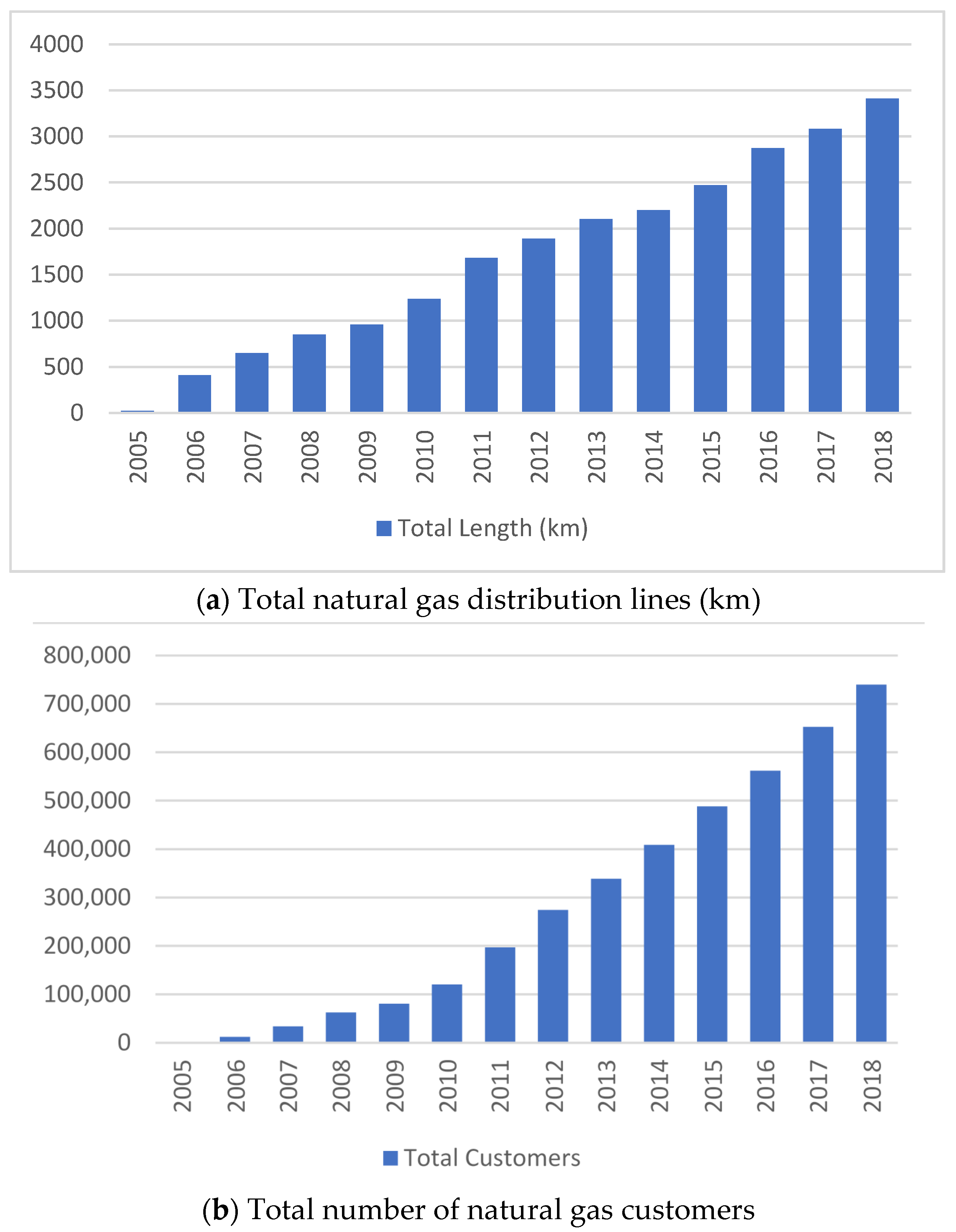

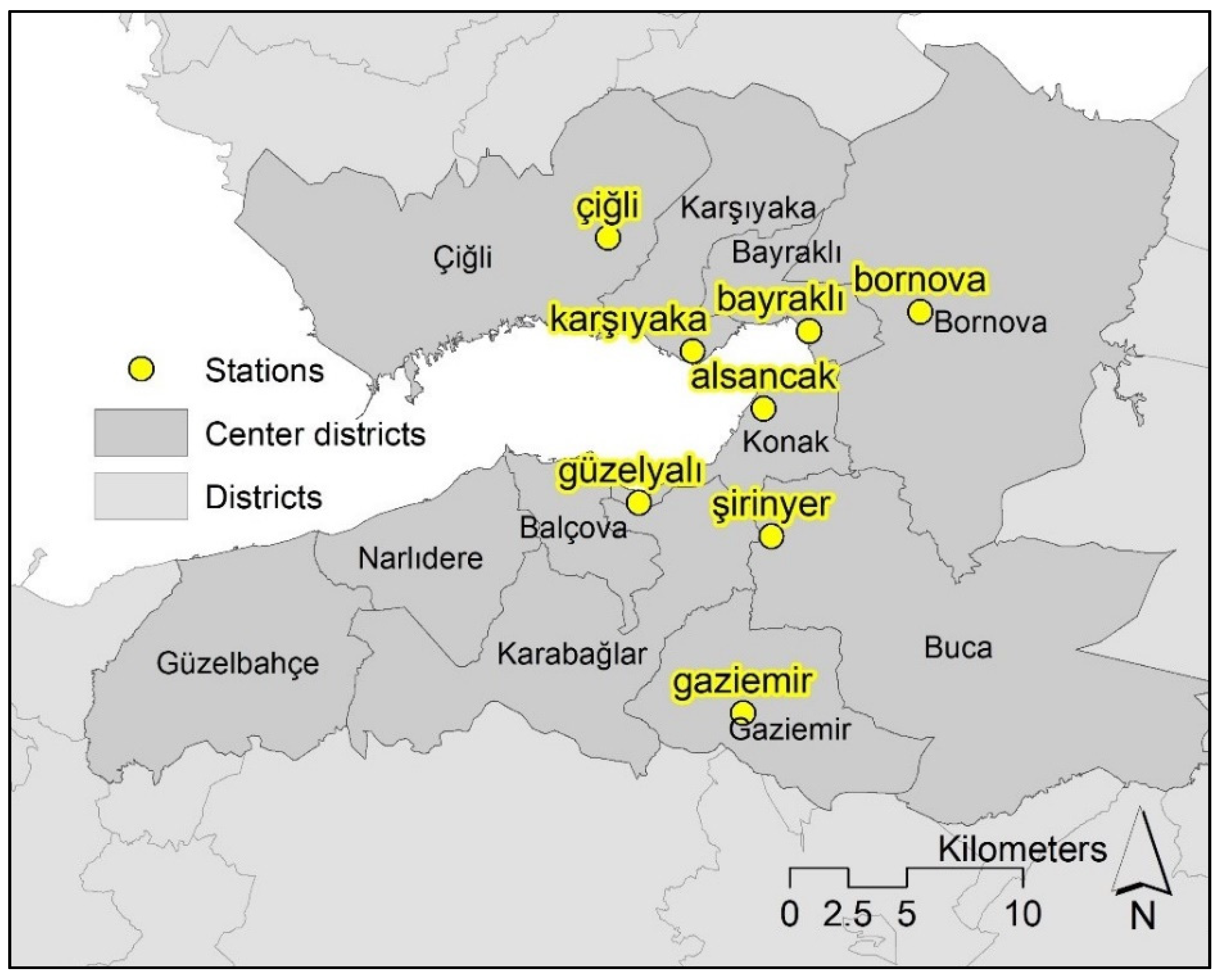
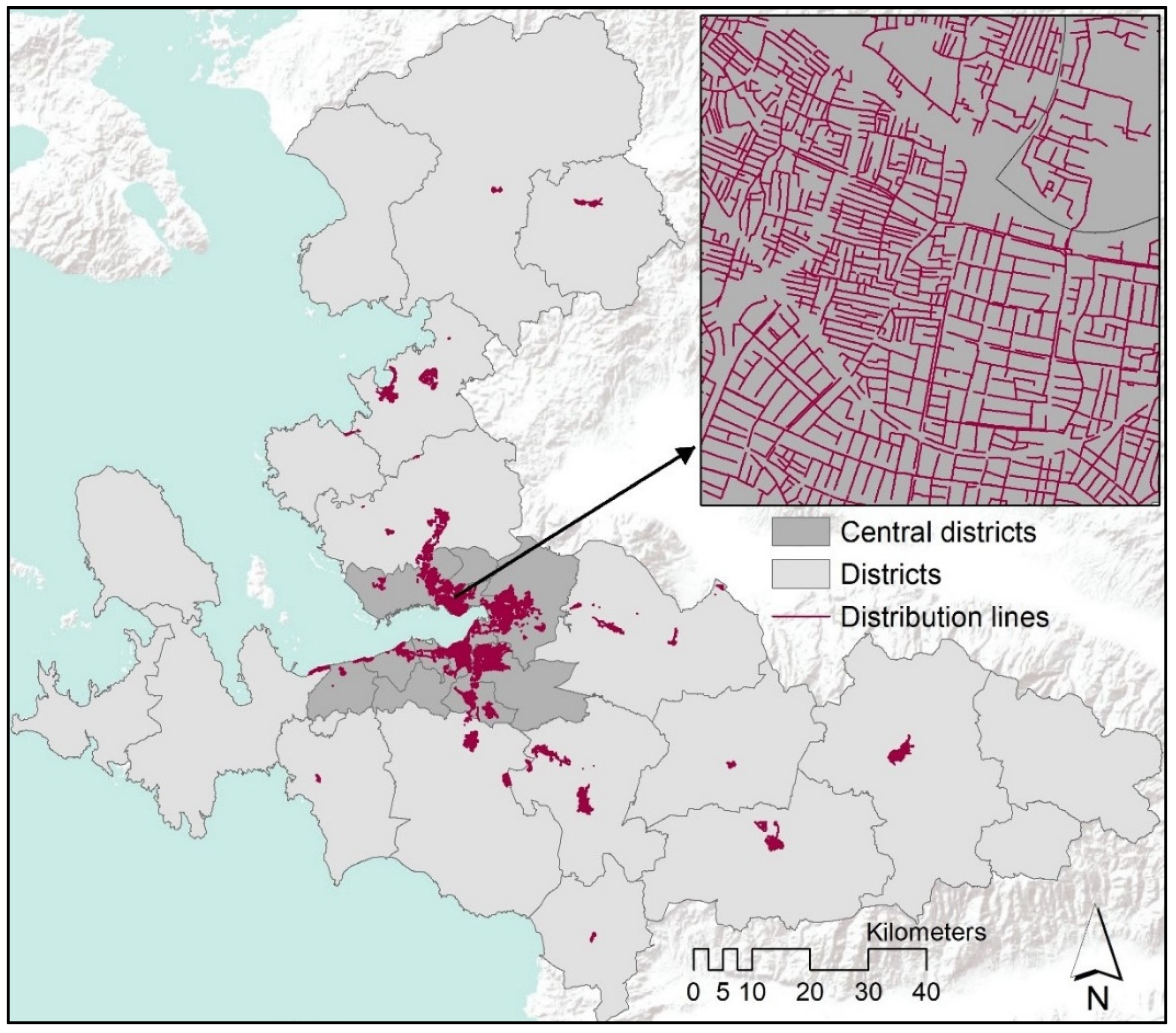

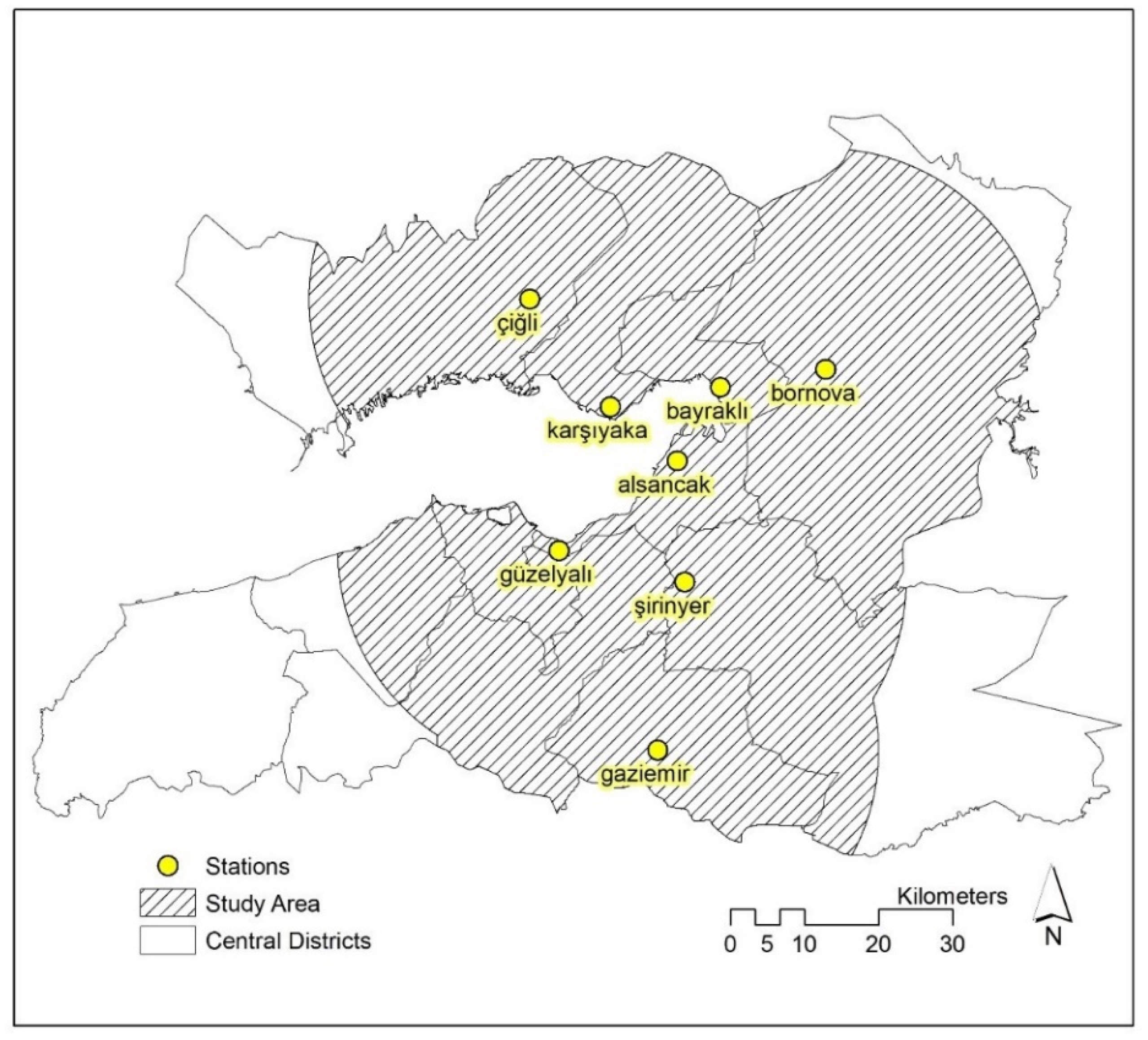
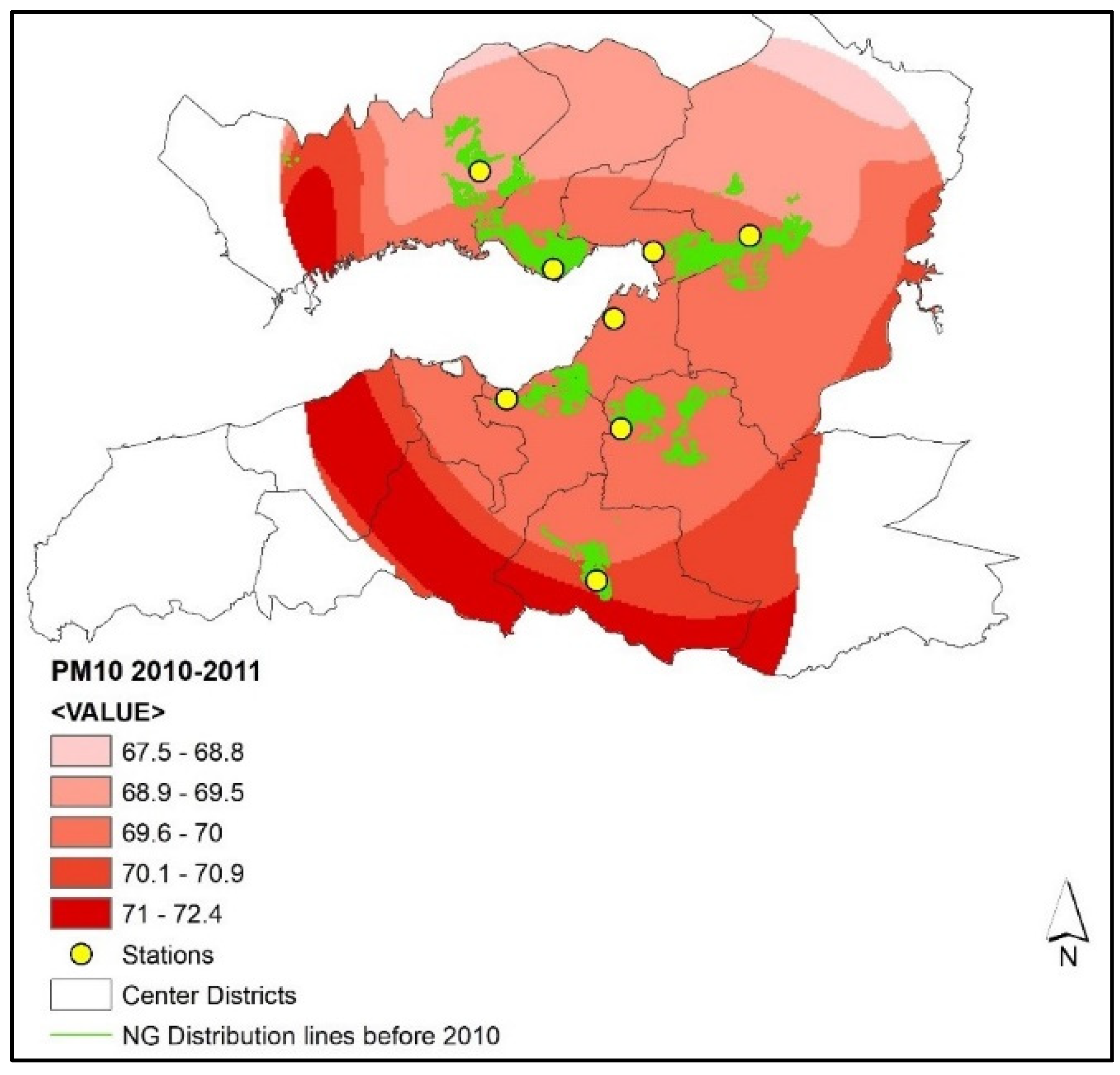



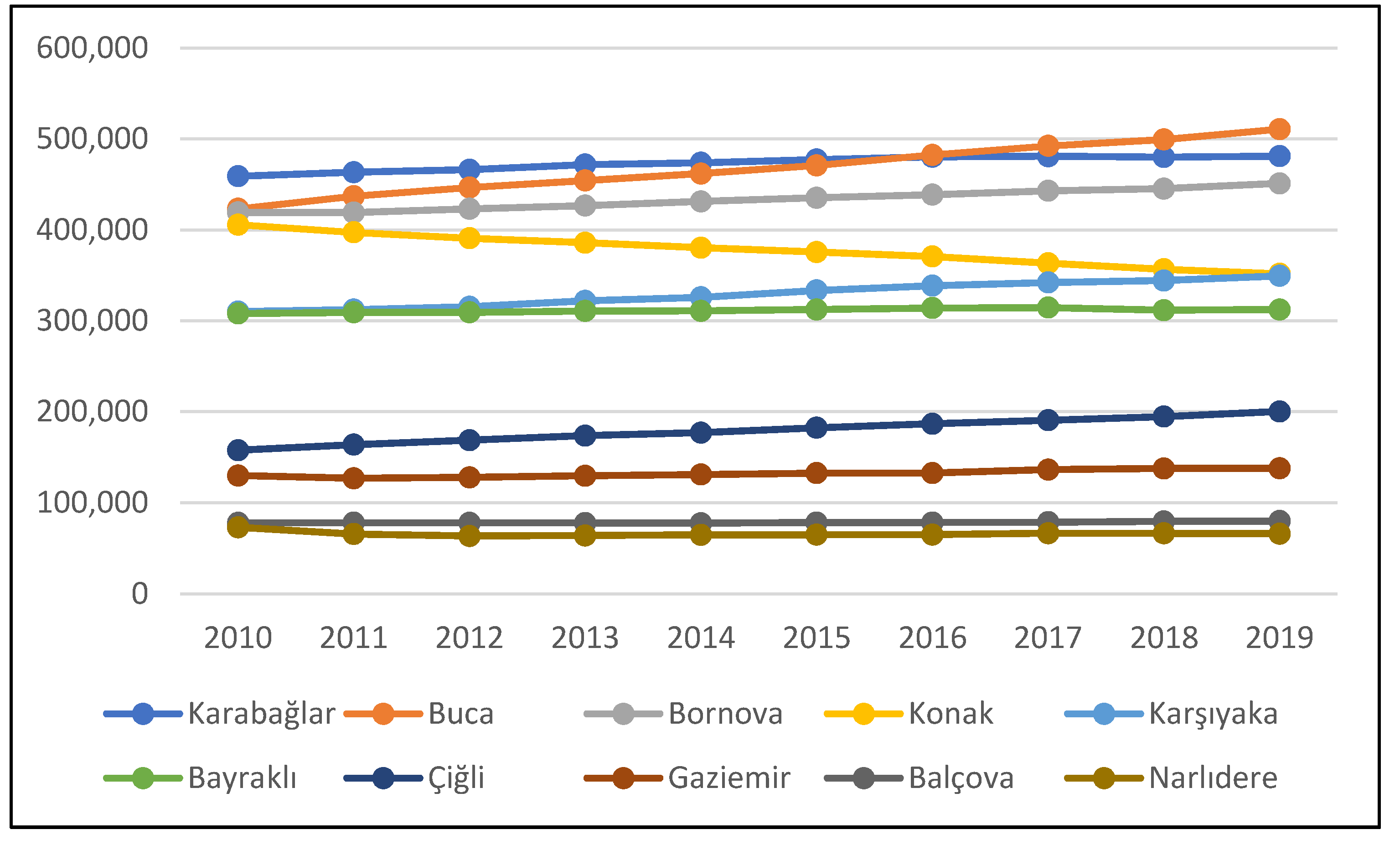
| Stations | Latitude | Longitude | PM10 2010–2011 (µg/m3) | PM10 2018–2019 (µg/m3) |
|---|---|---|---|---|
| Alsancak | 38°25′55″ | 27°08′39″ | 64.17 | 28.82 |
| Bayraklı | 38°27′43″ | 27°10′00″ | 94.69 | 56.35 |
| Bornova | 38°28′09″ | 27°13′17″ | 52.29 | 39.41 |
| Çiğli | 38°29′53″ | 27°04′04″ | 65.28 | 44.99 |
| Gaziemir | 38°18′51″ | 27°08′02″ | 71.96 | 40.12 |
| Güzelyalı | 38°23′44″ | 27°04′58″ | 68.61 | 43.02 |
| Karşıyaka | 38°27′15″ | 27°06′34″ | 58.16 | 28.48 |
| Şirinyer | 38°22′57″ | 27°08′53″ | 81.68 | 45.23 |
| Period | Method | Model | Range (m) | ME | MStdE | RMSE | RMS StdE | ASE |
|---|---|---|---|---|---|---|---|---|
| 2010–2011 | Ordinary Kriging | Spherical | 21,149 | 0.088 | 0.006 | 14.319 | 0.998 | 14.366 |
| 2018–2019 | Ordinary Kriging | Spherical | 20,143 | −0.065 | −0.006 | 9.741 | 0.999 | 9.769 |
Publisher’s Note: MDPI stays neutral with regard to jurisdictional claims in published maps and institutional affiliations. |
© 2021 by the authors. Licensee MDPI, Basel, Switzerland. This article is an open access article distributed under the terms and conditions of the Creative Commons Attribution (CC BY) license (https://creativecommons.org/licenses/by/4.0/).
Share and Cite
Senyel Kurkcuoglu, M.A.; Zengin, B.N. Spatio-Temporal Modelling of the Change of Residential-Induced PM10 Pollution through Substitution of Coal with Natural Gas in Domestic Heating. Sustainability 2021, 13, 10870. https://doi.org/10.3390/su131910870
Senyel Kurkcuoglu MA, Zengin BN. Spatio-Temporal Modelling of the Change of Residential-Induced PM10 Pollution through Substitution of Coal with Natural Gas in Domestic Heating. Sustainability. 2021; 13(19):10870. https://doi.org/10.3390/su131910870
Chicago/Turabian StyleSenyel Kurkcuoglu, Muzeyyen Anil, and Beyda Nur Zengin. 2021. "Spatio-Temporal Modelling of the Change of Residential-Induced PM10 Pollution through Substitution of Coal with Natural Gas in Domestic Heating" Sustainability 13, no. 19: 10870. https://doi.org/10.3390/su131910870
APA StyleSenyel Kurkcuoglu, M. A., & Zengin, B. N. (2021). Spatio-Temporal Modelling of the Change of Residential-Induced PM10 Pollution through Substitution of Coal with Natural Gas in Domestic Heating. Sustainability, 13(19), 10870. https://doi.org/10.3390/su131910870






